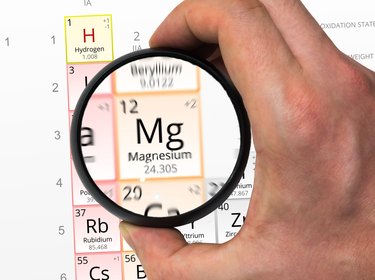
Magnesium, calcium, potassium and sodium appear tightly clustered in the periodic table. Elements that appear close to each other on the table are related and tend to share many common properties. Given that these four elements are so chemically similar, it is not surprising that they function in your body together as electrolytes. An electrolyte is a biologically active chemical that carries a charge.
Alkali Metal
Video of the Day
Both sodium and potassium are in the first vertical column of the periodic charge, making them Group 1 alkali metals. Alkali metals are extremely reactive. For example, dropping even a small amount of pure sodium metal in room temperature water creates an intensely strong reaction that produces high temperatures and generates hydrogen gas. These metals are always found in combination with another element because that stabilizes the metal. Common salts formed by these metals include sodium chloride and potassium chloride.
Video of the Day
Alkaline Earth Metals
Both magnesium and calcium are in the second vertical column on the periodic chart. Like all Group 2 elements, magnesium and calcium are alkaline earth metals. They are both soft, silver-colored metals that react quickly with halogen gases such as fluorine, chlorine and bromine to form salts. Both react with water to form strong basic solutions with a pH greater than 7. This group reacts more slowly with water than Group 1 metals, so magnesium reacts only with steam and calcium requires hot water to form basic solutions.
Chemical Periods
Magnesium and sodium appear next to each other in the third horizontal row, making them period three elements. Together, they form the S-block of this period. This means that their highest-energy electron is in the S-orbital shell. This configuration explains, in part, why these elements are so very reactive.
Potassium and calcium both appear next to each other in the fourth row of the periodic chart, making them period four elements. Like magnesium and sodium, their outer electrons are all in the S shell.
Biological Similarities
All four of these minerals occur in nature. Deficiencies due to lack of dietary intake are rare because all four are found in most foods. Even calcium, which many people take regularly for bone health, is rarely lacking in people. The issue with calcium supplementation isn't so much whether the person is getting enough calcium as whether the calcium they get is absorbed into bone. True deficiencies of these minerals usually indicate another problem, such as anorexia or alcoholism.
The serum concentration of all of these minerals is tightly regulated by the kidneys. Keeping a steady serum concentration sodium, potassium and calcium is critical because they are all involved in conducting signals from one nerve to another.
Biological Uses
These chemicals also serve many purposes outside of the serum. Both Calcium and potassium are widely distributed in bone. Magnesium is part of every ATP molecule and is involved in DNA and RNA synthesis. As such, it is necessary for almost all biochemical reactions and for growth. Sodium is involved in regulating blood volume and nutrient absorption.
- Los Alamos National Laboratory: Periodic Table of the Elements
- NASA Genesis Mission: The Modern Periodic Table
- Linus Pauling Institute; Calcium; Jane Higdon, Ph.D.; April 2003
- Linus Pauling Institute; Potassium; Jane Higdon, Ph.D.; Feb. 2004
- Linus Pauling Institute; Magnesium; Jane Higdon, Ph.D.; April, 2003
- LInus Pauling Institute; Sodium: Jane Higdon, Ph.D.; Feb. 2004